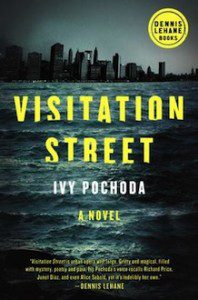
In the opening act of Ivy Pochoda’s Visitation Street, two teenage girls impulsively set out into the Erie Basin on a rubber raft given to them by some older boys. Hot and stir-crazy on a summer night, Valerie Marino has decided what the gift of a rubber raft is for—“take a float in the bay, cool off, see what’s what from the water.” Between a deserted sugar refinery and the Beard Street Pier, Val and June launch the raft into the swirling waters of the bay, and then, in three ominous words, “they are gone.”
The novelist Richard Ford opens his 2012 novel, Canada, with the following lines: “First I’ll tell about the robbery our parents committed. Then about the murders, which happened later.” In a television interview, Ford talks about beginnings that “throw down the gauntlet for the reader.” A great opening, he cautions, must be followed by an equally gripping second act. At the end of the dramatic first chapter of Visitation Street, I wondered where the novel would go next. I thought about Ford’s interview and his novel, which examines the repercussions of a single impulsive act on a fifteen-year-old boy and his family. The robbery in Ford’s Canada serves less as a plot devise than a window into questions of choice, family, and the disorderly, incalculable nature of life. Similarly, the disappearance of two teenage girls in Visitation Street creates narrative suspense, but serves primarily as a lens to explore the reverberations of tragedy in a tight-knit community. After the girls disappear in the opening chapter, Val is found unconscious under a pier by her teacher, Jonathan Sprouse, who comes in and out of the book under a cloud of suspicion, and from the moment Val regains consciousness, the reader is urged forward by the question, what happened to June Giotto?
A missing teenager coupled with hints of foul play would seem to place Visitation Street in familiar mystery-thriller territory, except that the novel explodes so many of the established tropes of the genre. For example, five primary characters are given a point of view and none of these characters is a detective. In telling the story from the perspective of multiple characters, Pochoda evokes a sense of collective grief, while displacing the authoritative figure of law enforcement. Instead of being told who to suspect through the singular point of view of a detective, our apprehensions emerge organically as we observe people living their lives in the aftermath of June’s disappearance. In the hands of a less skilled novelist, this polyphonic narration might dissipate the drama, but Pochoda’s use of third person multiple point of view serves to paint a unique portrait of a community drawn together and pulled apart by grief, while at the same time creating a fully realized emotional arc for each primary character.
In another turn from the traditions of the mystery genre, the novel’s thick description and lush prose invite readers to steep in the heady elixir of the dockside neighborhood. In Red Hook, the sound of laughter “falls from the windows,” while a “brew of fuel and fish” permeates the air. Across the water, “tankers, like shining islands, sit heavy and motionless” against the “Jurassic fantasyland” of cranes. These images and sensations spring from the page, as does the description of Val and June:
The girls, once a matched set, now seem to be fashioned from different material. Val whose pale skin repels the sun, is made of reeds and twigs—like the sad saplings planted in the park that shoot up but never seem to leaf out. June, blessed with an olive complexion even in winter, is formed from something soft and pliant, clay, maybe, or cookie dough.
Far from the sense of comfort so often associated with home, Pochoda’s Red Hook invokes an ambivalent, “end of the world feeling…a sense that [one] can go no farther and still never be found.” But Visitation Street plays as much on effervescent personalities and close-knit relationships as decrepit landmarks and quirky taverns. There is Jonathan Sprouse, the girls’ school teacher/piano bar virtuoso, his drag queen sidekick, Dawn Perignon, and his tattooed lover, Lil, with whom he has unremarkable sex that he thinks of as a late-night mistake. At one point, Jonathan’s eye turns to Valerie Marino, who is trying to figure out how to be a teenager in the shadow of dockyards and housing projects. Val evokes the empathy of a traditional heroine as she negotiates the murky waters of adolescence. Lonely yet never alone, her every move is informed by the loss of her best friend June, the inexplicable absence against which she guides and measures herself.
The haunted quality of Visitation Street reaches its height in those scenes where the memory of one character infuses the thoughts of another. Monique James catalogues food and household objects, but as the cadence of her obsession becomes more insistent, the words more charged—Water, watered, wave, unwavering—we realize that the memory of June has become a facet of Monique’s consciousness as she grapples with her anxiety about the way she treated June before she disappeared. Similarly, Val hears June’s voice echoing in her mind and cannot block out her classmates who chatter about what happened to June.
These enmeshed relationships take center stage in Pochoda’s novel, revealing the unique intimacies borne of proximity and isolation in a community cut off from the heart of New York by freeway construction. Every street corner in Red Hook reflects this sense of co-presence—from the quotidian exchanges between a Lebanese bodega owner, Fadi, and a local wino whose Spanglish dialect is tangled like his community, to the affairs of Cree James, who is tied to Red Hook by the memory of his murdered father and a mother who speaks to her dead husband from a park bench outside the development.
It may take an eye for subtlety to see hope in the characters that populate Visitation Street. The abandoned dockyards and rotting factories of Red Hook are not a playground for the privileged, and there are those who will shy away from the novel’s dirty realism. But for a reader like me, and for those who enjoy writers like Carson McCullers, Jennifer Egan, or Jayne Anne Phillips, the haunting waterfront community is home. I found myself taking a mental walk through the rough L.A. neighborhood where I grew up and imagining the New York borough where my grandmother labored in a bodega to support five boys after her husband died. Ivy Pochoda’s Red Hook is composed of the sublime energy and small acts of kindness that arise out of displacement and necessity; it is the kind of community that inspires nostalgia for an older way of life and reminds us of the things we’ve lost in an era of fortified suburban enclaves, gentrified inner cities, and fleeting internet groups. Like Fadi, who opens his bodega and hears “the voices over his shoulder…coming into concert, finding their own harmony to lift this place up and carry it along,” I find hope in the voices of community and survival on Visitation Street.





